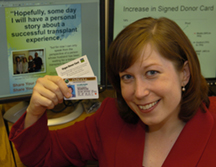
April 11, 2006
Hollywood organ donation myths challenged at the workplace
WEST LAFAYETTE, Ind. – The television and motion picture industries are scaring people away from donating organs, says a Purdue University health communication expert.

|
"Fictitious story lines that focus on a black market for organs or doctors who murder patients for their organs are taking their toll," says Susan Morgan, an associate professor of communication who is tracking how organ donation is portrayed on television.
To combat such myths, Morgan is taking a more personal approach to informing people about organ donation through the New Jersey Workplace Partnership for Life, which provides tailored health campaigns in workplace settings.
Morgan is working with 45 New Jersey organizations, including Johnson & Johnson, Fuji Film, L'Oreal Paris, Ethicon, Pathmark, Robert Wood Johnson Hospital and the New Jersey Department of Labor, to encourage more people to sign up as potential organ donors. The project is supported by a $1.67 million grant from the U.S. Department of Health and Human Services' Division of Transplantation.
The Organ Procurement and Transplantation Network and the Division of Transplantation Services estimate that 90,000 people are waiting for transplants, but most will not receive a transplant in time. Fewer than 40 percent of Americans have signed organ donor cards, and only about half of their families consent to the donation of a loved one's organs. Hearts, intestines, kidneys, livers and lungs are just some of the organs that can be transplanted.
Organ donation is often acknowledged as an honorable choice, but many people do not sign up to donate or do not talk to their family members about their decision.
Morgan says emotional and gripping story lines in television shows about organ donation often lead to public misconceptions. Programs have featured stories about murderers stealing organs to sell on the black market, doctors declaring death prematurely to save a friends' life, corruption in the medical system to procure organs for wealthy or famous people, and treating people who are organ donors only as sources for spare parts. Morgan says the shows rarely emphasize that decisions regarding organ transplants are made on the basis of a number criteria that are entered into a national computer system, which, instead of just one doctor, determines who receives transplants. Tissue typing and finding matches are highly regulated procedures in the United States.
"Few of the scenarios are even close to being accurate," Morgan says. "Many television writers and producers do not realize how many people believe that what happens on their favorite TV shows is real, especially medical and crime shows, and, as a result, many are scared to sign up to be organ donors. These shows are fiction, and the people watching them realize that on an intellectual level, but after being engrossed in an emotional and moving tale, it's hard to not believe it's true. Many viewers will say that even though it's fiction, 'there is always a kernel of truth.'
"As long as Hollywood continues to perpetuate misinformation, then we will need to educate the public one-on-one. And we're finding that the workplace is a great way to do this."
Morgan says the workplace program is seeing positive results, mostly because the project utilizes each company's intranet Web site, newspapers, newsletters and posters to feature stories from co-workers about how organ donation has touched their lives. For example, the posters may include a family photo and a quote that says, "My father-in-law is a walking testament to the power of organ donation" or "Without their decision to donate, my mom would not be with us today."
"People spend a lot of time with co-workers, and over time they do become like family," Morgan says. "Knowing the personal stories of a person's co-workers makes a difference, and it becomes easier to make a personal connection with the issue of organ donation.
"When employees see people they know who are desperately waiting for a transplant for a family member or hear the stories of hope from people who survived a fatal illness only because of a donor's heroic act, this may make a significant impact on donation rates."
Morgan says the ultimate goal is to encourage more people to sign up to be organ donors, but more importantly, she wants people to make an informed decision based on facts and not myths.
Companies are interested in participating, Morgan says, because of the program's sense of community, as well as the potential to hold down long-term medical costs associated with keeping patients on a waiting list. What is learned from this project also could benefit other health-related initiatives in the workplace, Morgan says.
"We're also observing how the physical layout of office space or other structural features can affect employee communication about health issues, which will affect the results of the campaign," she says.
For example, factors such as location of bulletin boards, the number of buildings employees work in, the number of floors in each building and the availability of central gathering points can influence people's participation in a program advocating lifestyle changes.
Later this year, an article featuring the result of Morgan's television analysis of organ donation will be published in Health Communication.
Writer: Amy Patterson Neubert, (765) 494-9723, apatterson@purdue.edu
Source: Susan Morgan, (765) 494-9108, smorgan@cla.purdue.edu
Purdue News Service: (765) 494-2096; purduenews@purdue.edu
Note to Journalists: April is National Donate Life Month.
Related Web site:
Purdue Department of Communication
PHOTO CAPTION:
Susan Morgan, an associate professor of communication at Purdue, is tracking how organ donation is portrayed on television, and she has found many inaccuracies. Morgan also is evaluating if developing a workplace campaign that uses a more personal approach to informing people about organ donation encourages more people to sign up to be donors. Her program, through the New Jersey Workplace Partnership for Life, provides tailored health campaigns in workplace settings. (Purdue News Service photo/David Umberger)
A publication-quality photo is available at https://www.purdue.edu/uns/images/+2006/morgan-organ.jpg
To the News Service home page